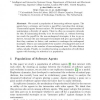41 search results - page 6 / 9 » Adaptation and Learning in Animated Creatures |
HUMO
2007
Springer
14 years 2 months ago
2007
Springer
Abstract. Learned, activity-specific motion models are useful for human pose and motion estimation. Nevertheless, while the use of activityspecific models simplifies monocular t...
CEC
2010
IEEE
13 years 9 months ago
2010
IEEE
For any embodied, mobile, autonomous agent it is essential to control its actuators appropriately for the faced task. This holds for natural organisms as well as for robots. If sev...
AROBOTS
1999
13 years 8 months ago
1999
Abstract. Classical conditioning is a basic learning mechanism in animals and can be found in almost all organisms. If we want to construct robots with abilities matching those of ...
ITS
2004
Springer
14 years 1 months ago
2004
Springer
Abstract. We describe Wayang Outpost, a web-based ITS for the Math section of the Scholastic Aptitude Test (SAT). It has several distinctive features: help with multimedia animatio...
AAMAS
2002
Springer
13 years 8 months ago
2002
Springer
We control a population of interacting software agents. The agents have a strategy, and receive a payoff for executing that strategy. Unsuccessful agents become extinct. We investi...

